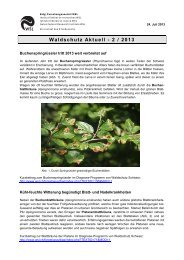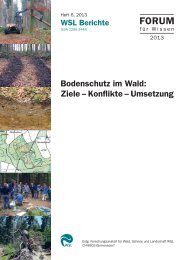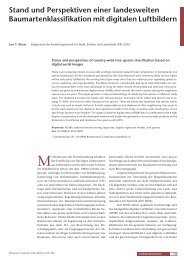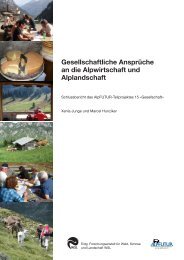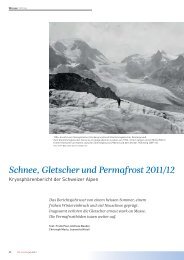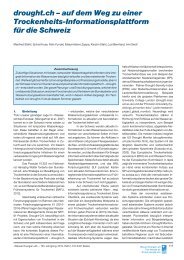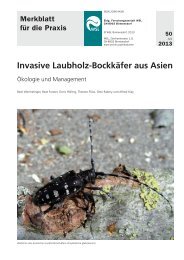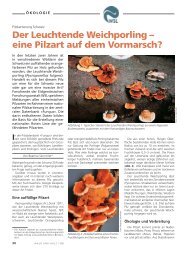Ecology and management of the spruce bark beetle Ips ... - WSL
Ecology and management of the spruce bark beetle Ips ... - WSL
Ecology and management of the spruce bark beetle Ips ... - WSL
You also want an ePaper? Increase the reach of your titles
YUMPU automatically turns print PDFs into web optimized ePapers that Google loves.
logs are too dry for breeding, <strong>the</strong> large populations are<br />
forced to infest living, apparently vital <strong>spruce</strong> trees. In<br />
such epidemic situations I. typographus can pose a<br />
serious threat to forests rich in <strong>spruce</strong>, especially to<br />
planted st<strong>and</strong>s outside <strong>the</strong>ir optimum area range.<br />
Most <strong>of</strong> <strong>the</strong> biological characteristics <strong>of</strong> I. typographus<br />
are well known, apart from topics such as<br />
overwintering behavior or various aspects <strong>of</strong> sister<br />
brood production. Despite this knowledge, <strong>the</strong> population<br />
dynamics <strong>of</strong> I. typographus is far from fully<br />
understood <strong>and</strong> even far<strong>the</strong>r from being predictable.<br />
To a large extent, this is due to <strong>the</strong> uncertainty <strong>of</strong> <strong>the</strong><br />
wea<strong>the</strong>r <strong>and</strong> <strong>of</strong> o<strong>the</strong>r decisive events, such as storms or<br />
drought. In addition, <strong>the</strong> recovery process <strong>of</strong> weakened<br />
<strong>spruce</strong> trees, e.g. after strong winds, is difficult<br />
to assess <strong>and</strong> depends on <strong>the</strong> wea<strong>the</strong>r as well. Fur<strong>the</strong>rmore,<br />
human control measures affect <strong>the</strong> survival <strong>of</strong><br />
<strong>bark</strong> <strong>beetle</strong>s <strong>and</strong> <strong>the</strong>ir antagonists, as well as host<br />
availability <strong>and</strong> susceptibility. In practice, <strong>the</strong> efficacy<br />
<strong>of</strong> control measures varies greatly, depending on<br />
whe<strong>the</strong>r <strong>the</strong>y are carried out in time <strong>and</strong> thoroughly<br />
enough.<br />
Outbreaks are usually caused by disturbances or<br />
extreme wea<strong>the</strong>r conditions. Extensive windthrows in<br />
<strong>spruce</strong> forests almost inevitably give rise to subsequent<br />
outbreaks <strong>of</strong> I. typographus. The populations<br />
first develop in <strong>the</strong> fallen timber <strong>and</strong> <strong>the</strong>n <strong>the</strong> <strong>beetle</strong>s<br />
attack living trees along adjacent st<strong>and</strong> borders <strong>and</strong><br />
elsewhere in <strong>the</strong> forest nearby. Strong winds creating<br />
large windthrow areas also cause scattered windthrows<br />
in <strong>the</strong> vicinity <strong>and</strong> presumably also constitute<br />
a significant stress to <strong>the</strong> remaining st<strong>and</strong>ing trees.<br />
I. typographus populations can build up not only in<br />
large windthrows but also locally within <strong>the</strong> st<strong>and</strong>. The<br />
higher <strong>the</strong> pressure <strong>of</strong> I. typographus on <strong>the</strong> trees, <strong>the</strong><br />
less susceptible <strong>the</strong> trees need to be for an attack to be<br />
successful. The fur<strong>the</strong>r course <strong>of</strong> <strong>the</strong> outbreak depends<br />
on <strong>the</strong> regulatory influence <strong>of</strong> natural enemies <strong>and</strong><br />
sanitation measures <strong>and</strong> in particular, on <strong>the</strong> susceptibility<br />
<strong>of</strong> <strong>the</strong> remaining trees. This in turn depends to a<br />
large extent on <strong>the</strong> wea<strong>the</strong>r since drought or wind are<br />
additional stresses on <strong>the</strong> trees recovering from <strong>the</strong><br />
storm. Given ‘normal’ conditions an outbreak usually<br />
lasts between three <strong>and</strong> six years. For a better underst<strong>and</strong>ing<br />
<strong>of</strong> this dynamics, existing risk analysis models<br />
from <strong>the</strong> viewpoint <strong>of</strong> <strong>the</strong> host trees should<br />
be combined with models <strong>of</strong> <strong>bark</strong>-<strong>beetle</strong> population<br />
dynamics. On a regional scale, <strong>the</strong> spatial develop-<br />
B. Wermelinger / Forest <strong>Ecology</strong> <strong>and</strong> Management 202 (2004) 67–82 77<br />
ment <strong>of</strong> infestations can be analyzed by GIS <strong>and</strong><br />
multiple regression techniques, to explore potential<br />
correlations between climatic, st<strong>and</strong> specific, <strong>and</strong><br />
phytosanitary factors <strong>and</strong> <strong>the</strong> infestation dynamics.<br />
These techniques provide valuable tools for risk<br />
assessments by pinpointing <strong>the</strong> most significant driving<br />
variables behind outbreaks. It might be possible to<br />
control some <strong>of</strong> <strong>the</strong>se by forest <strong>management</strong>.<br />
There are various strategies for minimizing <strong>the</strong> loss<br />
<strong>of</strong> <strong>spruce</strong> due to I. typographus. Pheromones <strong>and</strong> o<strong>the</strong>r<br />
semiochemicals are considered as just one among<br />
several components in integrated control. Pheromone<br />
traps can be useful for protecting susceptible st<strong>and</strong><br />
borders <strong>and</strong> for monitoring. However, trap catches are<br />
not only a measure <strong>of</strong> <strong>the</strong> abundance <strong>of</strong> I. typographus<br />
but also <strong>of</strong> <strong>the</strong> traps’ attractiveness relative to nearby<br />
natural pheromone <strong>and</strong> kairomone sources. Antiaggregation<br />
pheromones or mating disruption techniques<br />
are still in <strong>the</strong> early stage <strong>of</strong> development.<br />
However, it is questionable whe<strong>the</strong>r such techniques<br />
would be applicable <strong>and</strong> efficient on a large scale, <strong>and</strong><br />
<strong>the</strong>ir impact on <strong>the</strong> ecosystem still has to be evaluated.<br />
Salvage or ‘clean <strong>management</strong>’ is <strong>the</strong> oldest <strong>and</strong> at<br />
present still most efficient strategy. However, <strong>the</strong><br />
success <strong>of</strong> windthrow clearing <strong>and</strong> sanitation felling<br />
largely depends on <strong>the</strong>ir timely <strong>and</strong> thorough accomplishment.<br />
In many cases, this in turn depends on <strong>the</strong><br />
financial <strong>and</strong> human resources available <strong>and</strong> on timber<br />
prices. The economic situation, changes in forest<br />
functions, <strong>and</strong> ecological considerations, such as promoting<br />
dead wood, generating a more natural st<strong>and</strong><br />
composition, <strong>and</strong> enhancing biodiversity, have<br />
prompted various private <strong>and</strong> public forest owners<br />
to refrain from taking control measures in specific<br />
situations. Methods to identify <strong>the</strong> least spatial unit<br />
that allows efficient control measures <strong>and</strong> minimum<br />
measures required to ensure particular forest functions<br />
are fulfilled still need to be developed.<br />
Natural enemies probably play an important role in<br />
endemic situations <strong>and</strong> towards <strong>the</strong> end <strong>of</strong> an outbreak.<br />
Like I. typographus, <strong>the</strong>y also greatly depend on <strong>the</strong><br />
wea<strong>the</strong>r. We need to find out more about <strong>the</strong> efficiency<br />
<strong>of</strong> antagonists in various forest compositions, <strong>and</strong> <strong>the</strong>ir<br />
temporal population dynamics relative to that <strong>of</strong> I.<br />
typographus. It is unlikely that <strong>the</strong>se natural enemies<br />
will ever be employed in <strong>the</strong> sense <strong>of</strong> classical biological<br />
control. Ra<strong>the</strong>r, underst<strong>and</strong>ing <strong>the</strong> interactions<br />
between <strong>bark</strong> <strong>beetle</strong>s, antagonists, host plant <strong>and</strong>



